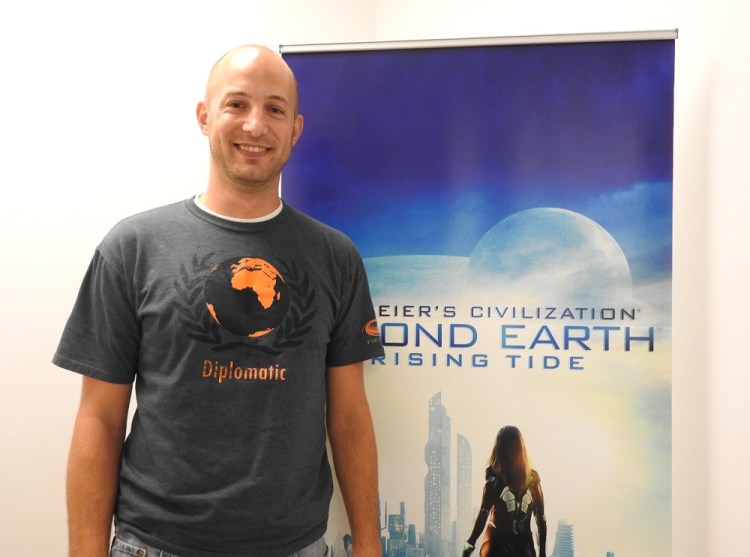Frederiksen: The North Sea Alliance, after the Great Mistake — these are a collection of the naval industries of the North Sea, the British isles and Scandinavia. They come together to survive, but eventually hit a point where they need to — the seeding already happened and all the initial factions left.
Now these guys need to leave too, but they have a nautical history. Their leader is one of those guys. He didn’t come with a silver spoon in his mouth. He wasn’t a politician all his life. He was a dockworker, a laborer, a bruiser. He’s as much a street guy as — I love his diplomacy lines, the voice over, because the voice actor who did this guy — we actually rewrote some of his lines for him, because he just had the character down, this rough and tough Scottish seaman turned politician.
GamesBeat: They have an advantage in the water, I take it?
Frederiksen: The North Sea Alliance is very much your land in the water, control the seas faction. That’s their direction, their goal. They have the ability to move their cities faster and have a higher defense on the water. They can still go on land, but if they do, they don’t have that advantage for their cities.
GamesBeat: The water looks prettier. You can see things underneath. Is there any functionality under these layers of water?
Frederiksen: Graphically, we have new shaders, new textures, new water tech. That’s all brand new. It’s now transparent, like you said. A lot of work went into making that look very good technically, but also provide visual clarity — seeing where it’s deep and where it’s shallow. Certain resources will appear more or less on different types. Initially you can only land or settle or move on shallow water with your water cities. Then you can research a tech to move out into the deep ocean. That’s one thing to factor in. The tiles will also have different yields based on that.
As multiple layers go, it’s not another orbital layer or anything like that. But you do have some things visually under the sea, over the sea. We have submarines coming in. Those are really fun, because we brought invisibility back. If you aren’t right there or if you don’t have the right unit in range, you won’t see the enemy submarines creeping around.
GamesBeat: The tech research tree was always a little intimidating to me. It was confusing as to which direction to go. On that front, what’s a normal strategy, something that will lead you in a good direction?
Frederiksen: I’ve heard almost every permutation. It’s that theorycrafting people like to do. “This works out really well. But this works, and this works…” Any general idea is viable. We have a large number of people who tend to buy the branch techs, the circle right around the center, and then start to buy out from there based on what affinity they want or what resources are near them. It’s a lot of reacting to what’s already there.
The safe bet is still, buy that ring and then pursue from there. The nice thing about that is, when you start that pursuit, because of the affinity pacing and how we’ve added more affinity to the branch techs — it used to only be the leaves, those lower levels. Now you can get it off the branch techs. You don’t have to deep dive on a tech to get an affinity. You can keep going up the branches to get further out and you’ll still gain some affinity. You’re not falling behind in the affinity race.
GamesBeat: Are there some other new features we haven’t mentioned yet?
Frederiksen: I don’t know if you ran into one of the marvels. Every biome now has what we call a marvel, which has an associated quest. The marvels are kind of Beyond Earth’s — they’re not natural wonders, but I’d start there as far as the mindset. They’re unique per biome. It’s a very large piece of art, like three hexes. The fungal biome has a super huge crazy mushroom.
This isn’t just a piece of art, too. When you find it, it triggers a quest. The quest is to go out and find out these related nodes. In the mushroom’s case it’s some other moderately-sized mushrooms that are only one hex big. But when you find them and investigate them — you take a unit there and do an investigation action — you can unlock their secrets. You then gain a bonus that’s unique to each biome.
These can be really huge effects. This one makes it so each small mushroom gives you increased food around it. That’s a great place to found a new city. But you have to take risks and explore and find these. We also have unique new alien stats and behavior for each biome. One biome, the aliens move slower.
Another one they have higher defense, but they spawn less often. We’ve made biomes have a bigger impact on each game of Beyond Earth, without totally redefining the rules.
VentureBeat's mission is to be a digital town square for technical decision-makers to gain knowledge about transformative enterprise technology and transact. Learn More



